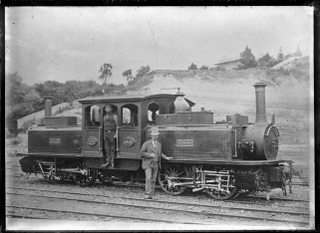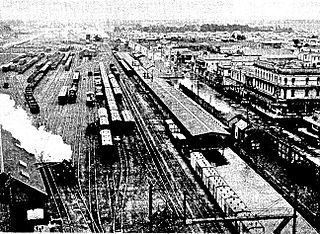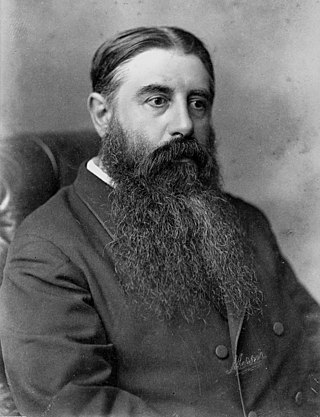
Railway preservation in New Zealand is the preservation of historically significant facets of New Zealand's rail transport history. The earliest recorded preservation attempt took place in 1925, although the movement itself did not start properly until 1960.
The Taonui Branch was a minor branch line railway in New Zealand's national network. Located in the Manawatū District of the North Island, it opened in 1879 and operated until 1895.

The Foxton Branch was a railway line in New Zealand. It began life as a tramway, reopened as a railway on 27 April 1876, and operated until 18 July 1959. At Himatangi there was a junction with the Sanson Tramway, a line operated by the Manawatu County Council that was never upgraded to the status of a railway.
Locomotives of New Zealand is a complete list of all locomotive classes that operate or have operated in New Zealand's railway network. It does not include locomotives used on bush tramways.

The NZR E class of Double Fairlie steam locomotives were two different types of Fairlie steam locomotives, used on New Zealand's railway network.

The NZR P class was a class of two 0-6-0ST locomotives built to work on the government-owned national rail network of New Zealand in 1876. They were initially ordered by the Otago Provincial Council, but they were soon incorporated into the national locomotive fleet when the provinces were abolished. Other examples of the P class were built for industrial service and never came under the ownership of the New Zealand Railways Department, though one worked on the Kaitangata Line.

The NZR B class of 1874 was the first of two steam locomotive classes to be designated as B by the Railways Department that then oversaw New Zealand's national rail network. Ordered from the Avonside Engine Company in 1874, the locomotives were of the Double Fairlie type and were the first British-built locomotives to feature Walschaerts valve gear. They were not the first Double Fairlies to operate in New Zealand, as the first two members of the E class had commenced operations in 1872.

The NZR R class was a class of early 0-6-4T single Fairlie steam locomotives operated by New Zealand's Railways Department (NZR) between 1879 and 1936.
The Wellington and Manawatu Line is an unofficial name for the section of New Zealand's North Island Main Trunk Railway between Wellington and Palmerston North. Originally a government project, the line was constructed by the private Wellington and Manawatu Railway Company and bought by the government in December 1908.
The Marton–New Plymouth line (MNPL) is a secondary railway in the North Island of New Zealand that links the Taranaki and Manawatū-Whanganui regions. It branches from the North Island Main Trunk railway (NIMT) at Marton and runs near the South Taranaki Bight of the west coast before turning inland, meeting the Stratford–Okahukura Line (SOL) at Stratford and running to New Plymouth. Construction of the line was completed in 1885, and along with the SOL it provided an alternate route to the NIMT with the SOL's completion in 1933 until the latter was mothballed in 2010. In its early days, the North Island's first regional express, the New Plymouth Express ran on the line, but it has been freight-only since the cancellation of passenger services on the line in 1977.
The Wanganui Branch is a 5.00 km branch line railway in the Manawatū-Whanganui region of New Zealand's North Island. It links Wanganui with the Marton - New Plymouth Line (MNPL) at Aramoho and has been open since 21 January 1878, although solely for freight traffic since 7 September 1959. Another branch line diverged from the Wanganui Branch near its terminus, the Castlecliff Branch.

The Castlecliff Branch is a branch line railway 5.88 km long in the Manawatu-Whanganui region of New Zealand's North Island. It is an extension of the Wanganui Branch from Taupo Quay in central Whanganui and follows the Whanganui River to Castlecliff on the South Taranaki Bight of the Tasman Sea. From its opening on 31 October 1885 until 1 February 1956 when the NZR took over, it was owned by the Wanganui Heads Railway Company, later renamed the Castlecliff Railway Company. From 5 September 2006 services on the branch were suspended but the infrastructure remained in place. In 2011 KiwiRail resumed services on part of the line.

The NZR S class was a class of seven 0-6-4T single Fairlie steam locomotives operated by New Zealand's Railways Department (NZR) between 1882 and 1927.

The Wellington and Manawatu Railway Company was a private railway company that built, owned and operated the Wellington-Manawatu railway line between Thorndon in Wellington, the capital of New Zealand, and Longburn, near Palmerston North in the Manawatu, between 1881 and 1908, when it was acquired by the New Zealand Government Railways. Its successful operation in private ownership was unusual for early railways in New Zealand.

Longburn railway station was a station in Longburn, on the North Island Main Trunk in New Zealand. The platform, which is across from the Fonterra Factory, remains but the structure has been demolished.

Palmerston North Central railway station was a station on the North Island Main Trunk in New Zealand and the Palmerston North–Gisborne Line. The station opened in 1876 and closed in 1963.
The Murupara Branch is a 57 kilometres (35 mi) long branch railway line from the East Coast Main Trunk (ECMT) at Kawerau to Murupara, built to serve a new pulp and paper mill harvesting the radiata pine trees of the Kaingaroa Forest on the Kaingaroa Plateau in the Bay of Plenty, New Zealand. The line was the last major extension of the New Zealand Railways Department (NZR) network, of 14 kilometres (8.7 mi) from Hawkens Junction, west of Edgecumbe, to Kawerau and 57 km from Kawerau to Murupara. The portion from Hawkens Junction to Kawerau was known as the Kawerau Branch until 1978, when it became part of the ECMT, and the former ECMT from Hawkens Junction to Taneatua became the Taneatua Branch.

The Vogel Era describes the history of New Zealand between 1873 and 1876, when the country adopted an immigration and public works scheme inaugurated by the colonial treasurer, then premier, Julius Vogel to develop the country and to relieve the slump of the late 1860s; to be financed by borrowing overseas. His "Great Public Works Policy" resulted in a large increase in migrants and provision of many new railways, roads and telegraph lines. The railway system developed from a few lines in three gauges to the start of a national network including the main line from Christchurch to Dunedin, though the narrow "Cape gauge" required later upgrading to increase the restricted height and weight limits.

The North–South Junction is a section of single-track rail line about 7 km long, north of Wellington, New Zealand between the closed (2011) Muri railway station and the (lower) Paekakariki railway station to the north. It is part of the Kapiti Line section of the North Island Main Trunk line between Wellington and Auckland, and part of the Wellington–Manawatu Line, built by the Wellington & Manawatu Railway Company (WMR).












